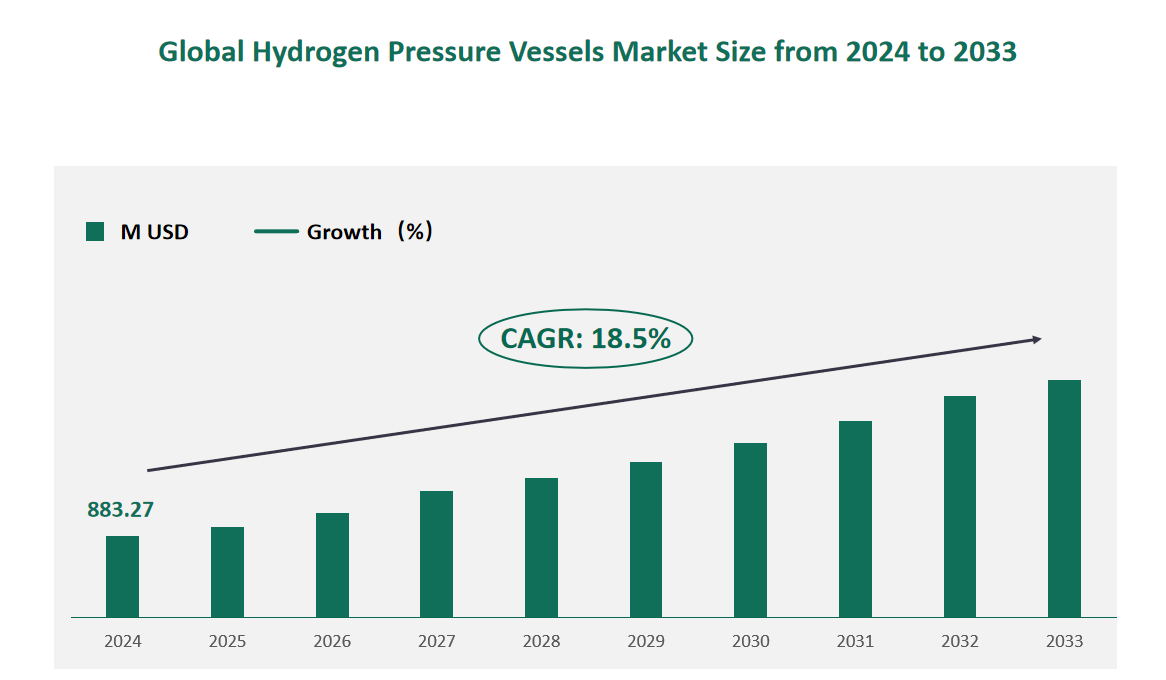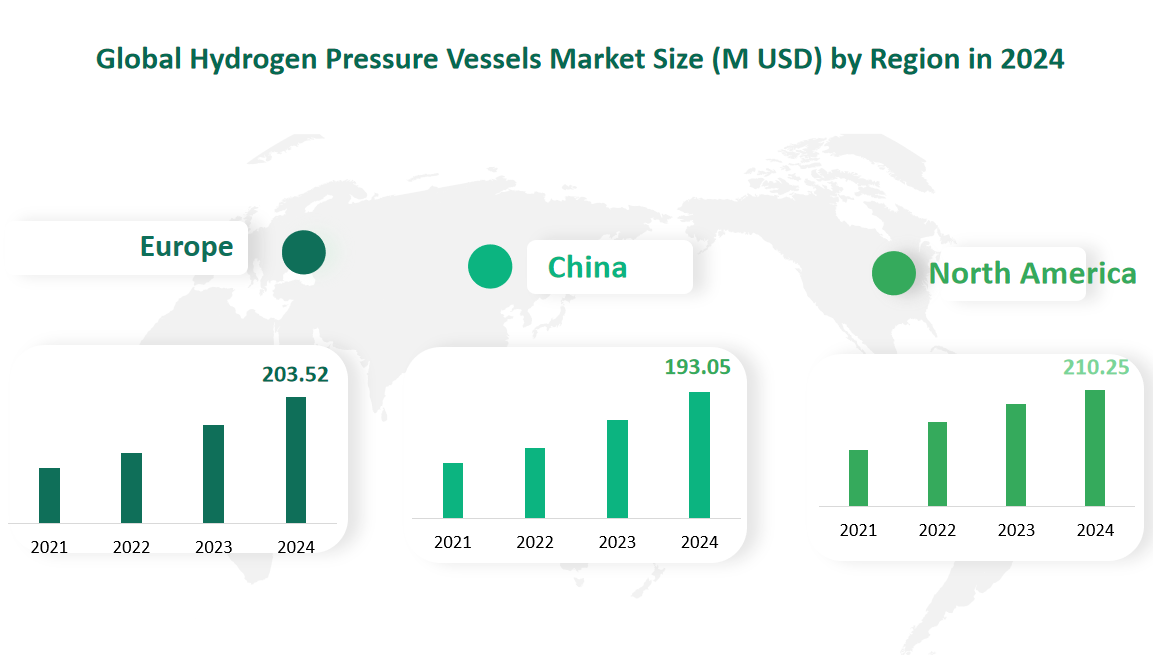1 Global Hydrogen Pressure Vessels Market Size (Value) and CAGR (2024-2033)
In 2024, the global Hydrogen Pressure Vessels market was valued at USD 883.27 million, with a CAGR of 18.5% from 2024 to 2033.
The hydrogen pressure vessel is a closed container used to store hydrogen, which can withstand a certain pressure load, and its materials include metal and non-metal materials. According to different materials, hydrogen pressure vessels are divided into metal bottles (Type I), metal liner fiber hoop wound bottles (Type II), metal liner fiber fully wound bottles (Type III), and non-metal liner fiber wound bottles (Type IV) 4 types.
Figure Global Hydrogen Pressure Vessels Market Size (M USD) and CAGR 2024-2033

2 Hydrogen Pressure Vessels Market Drivers
The global Hydrogen Pressure Vessels market is experiencing significant growth driven by several key factors. The primary driver is the increasing demand for low-emission fuels, particularly hydrogen, which is one of the cleanest burning transportation fuels available. Hydrogen contains less carbon than other fossil fuels, resulting in lower carbon dioxide emissions. This environmental benefit is driving the market as stricter regulations regarding cleaner fuels and engine emissions are being implemented globally.
Another significant driver is the technological advancement in hydrogen production and storage. The development of more efficient and cost-effective methods for producing hydrogen, along with improvements in hydrogen pressure vessel technology, is making hydrogen a more viable fuel option. Innovations in materials science, such as the use of advanced composites for Type III and Type IV vessels, have led to lighter, stronger, and safer storage solutions. These advancements are particularly important for the automotive industry, where hydrogen fuel cell vehicles are gaining traction.
Government policies and incentives are also playing a crucial role in driving the market. Governments around the world are promoting the use of hydrogen as a clean energy source through subsidies, tax incentives, and regulatory frameworks that support the development of hydrogen infrastructure.
3 Hydrogen Pressure Vessels Market Restraints
Despite the significant drivers, the Hydrogen Pressure Vessels market faces several limitations that could hinder its growth. One of the primary limitations is the high cost associated with the production of hydrogen pressure vessels, particularly those made from advanced composite materials. The raw materials, such as carbon fiber and resin, are expensive, and the manufacturing processes, including filament winding and curing, require significant capital investment. These high costs can limit the market’s penetration, especially in cost-sensitive applications.
The technical complexity involved in the design and manufacture of hydrogen pressure vessels is a significant limiting factor. The need for high-pressure containment and safety standards requires specialized knowledge and expertise. This complexity can lead to longer lead times and higher production costs, making it difficult for new entrants to compete with established players.
Supply chain issues also pose a challenge. The availability and reliability of raw materials, especially in the context of global economic fluctuations and geopolitical tensions, can impact the production and distribution of hydrogen pressure vessels. Disruptions in the supply chain can lead to delays and increased costs, affecting the overall market dynamics.
4 Global Hydrogen Pressure Vessels Market Size by Type in 2024
Type I vessels are made entirely of metal, typically steel or aluminum. These vessels are the simplest in design and have been used for many years. They are robust and reliable but are generally heavier and have lower hydrogen storage density compared to other types. In 2024, the market value for Type I vessels is projected to be 34.14 million USD. These vessels are commonly used in industrial applications where weight is less of a concern, such as in stationary hydrogen storage systems.
Type II vessels feature a metal liner with a hoop-wound composite overwrap. This design combines the strength of metal with the lightweight properties of composite materials, resulting in a vessel that is both strong and lighter than Type I vessels. The market value for Type II vessels in 2024 is expected to be 51.16 million USD. Type II vessels are often used in applications where weight reduction is important but not as critical as in Type III and Type IV vessels, such as in some industrial mobile applications.
Type III vessels have a metal liner with a full composite overwrap. This construction provides a significant improvement in weight reduction and hydrogen storage density compared to Type I and Type II vessels. The market value for Type III vessels in 2024 is forecasted to be 259.82 million USD. Type III vessels are widely used in automotive applications, particularly in hydrogen fuel cell vehicles, where weight and storage efficiency are crucial factors.
Type IV vessels are the most advanced, featuring a non-metal liner (usually made of plastic) with a full composite overwrap. These vessels offer the highest hydrogen storage density and are the lightest of all types. The market value for Type IV vessels in 2024 is projected to be 538.16 million USD. Type IV vessels are the preferred choice for high-performance applications, such as in passenger cars and commercial vehicles, where maximizing hydrogen storage capacity and minimizing weight are essential.
Table Global Hydrogen Pressure Vessels Market Size by Type in 2024
Type | Market Size (M USD) 2024 |
Type I | 34.14 |
Type II | 51.16 |
Type III | 259.82 |
Type IV | 538.16 |
5 Global Hydrogen Pressure Vessels Market Size by Application in 2024
Industrial applications are a significant segment of the Hydrogen Pressure Vessels market. These applications primarily involve the storage and transportation of hydrogen for use in various industrial processes, such as chemical production, refining, and power generation. In 2024, the market value for industrial applications is projected to be 440.60 million USD. The growth in this segment is driven by the increasing demand for hydrogen in industrial processes, particularly as companies seek to reduce their carbon footprint and transition to cleaner energy sources.
The automotive sector is another major application area for Hydrogen Pressure Vessels. These vessels are used in hydrogen fuel cell vehicles, where they store hydrogen to power the vehicle’s fuel cells. The market value for automotive applications in 2024 is expected to be 379.48 million USD. The growth in this segment is driven by the increasing adoption of hydrogen fuel cell vehicles, which offer a zero-emission alternative to traditional gasoline-powered vehicles. Governments around the world are also supporting the development of hydrogen infrastructure to facilitate the growth of this market.
Table Global Hydrogen Pressure Vessels Market Size by Application in 2024
Application | Market Size (M USD) 2024 |
Industrials | 440.60 |
Automotive | 379.48 |
Others | 63.19 |
6 Global Hydrogen Pressure Vessels Market Size by Region in 2024
North America is a significant market for Hydrogen Pressure Vessels, driven by the United States’ leadership in technology and innovation. In 2024, the market value in North America is projected to be 210.25 million USD. The region’s growth is supported by strong government policies promoting clean energy and the development of hydrogen infrastructure. The presence of major automotive manufacturers and technology companies also contributes to the region’s market growth.
Europe is another key region for Hydrogen Pressure Vessels, with a projected market value of 203.52 million USD in 2024. The region’s growth is driven by stringent environmental regulations and a strong commitment to reducing carbon emissions. European countries are investing heavily in hydrogen infrastructure, including hydrogen refueling stations and production facilities. The automotive industry in Europe is also a significant driver, with many manufacturers developing hydrogen fuel cell vehicles.
China is experiencing rapid growth in the Hydrogen Pressure Vessels market, driven by countries like China and Japan. In 2024, the market value in the Asia-Pacific region is expected to be 193.05 million USD. The region’s growth is further supported by increasing industrial demand for hydrogen.
Figure Global Hydrogen Pressure Vessels Market Size by Region in 2024

7 Major Players in Global Hydrogen Pressure Vessels Market
7.1 ILJIN Hysolus CO., LTD.
Company Profile: Established in 1999, headquartered in South Korea, with manufacturing sites in South Korea.
Business Overview: It focuses on providing hydrogen mobility solutions. The company offers a range of products including hydrogen solutions, CNG solutions, diesel solutions, and other services.
Product Introduction: Its hydrogen tanks, made with ultra – light composite material technology, are safe and lightweight. They have passed stress and minimum tests for regulations and certifications. The company provides storage tanks and optimal storage systems for various applications, such as in forklifts, ships, trains, passenger cars, and commercial vehicles. In 2023, its production volume was 35.1 K Units, resulting in a value of 94.00 M USD.
7.2 Hexagon Composites ASA
Company Profile: Founded in 1963, headquartered in Norway, with manufacturing sites in Europe and North America.
Business Overview: It is a composite cylinder technology company enabling the safe delivery of clean energy in gaseous form and decarbonizing transportation.
Product Introduction: Their hydrogen high – pressure Type 4 cylinders have features like high fatigue strength, lightweight, being certified and standardized, and non – corroding. In 2023, the production was 24.7 K Units, the price was 2863 USD/Unit, the value reached 70.70 M USD.
7.3 Toyota
Company Profile: Established in 1937, headquartered in Japan, with manufacturing sites in Japan.
Business Overview: Toyota is a well – known car manufacturer involved in vehicle design, manufacturing, and marketing. It also has businesses in housing, financial services, telecommunications, and information technology.
Product Introduction: The high – pressure hydrogen tank produced at the Inabe Plant is a crucial component for fuel cell vehicles (FCVs). It efficiently holds hydrogen compressed at high pressure, contributing to the extension of the FCV’s cruising range. In 2023, Toyota’s production volume was 16.5 K Units, the price was 2689 USD/Unit, the value was 44.36 M USD.

